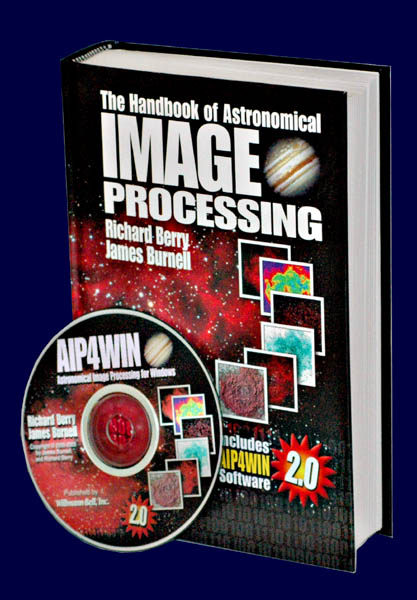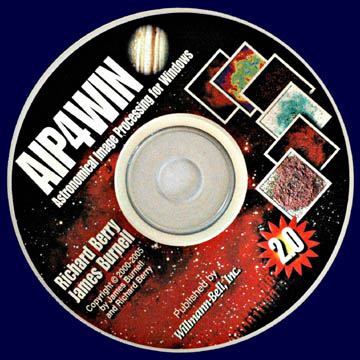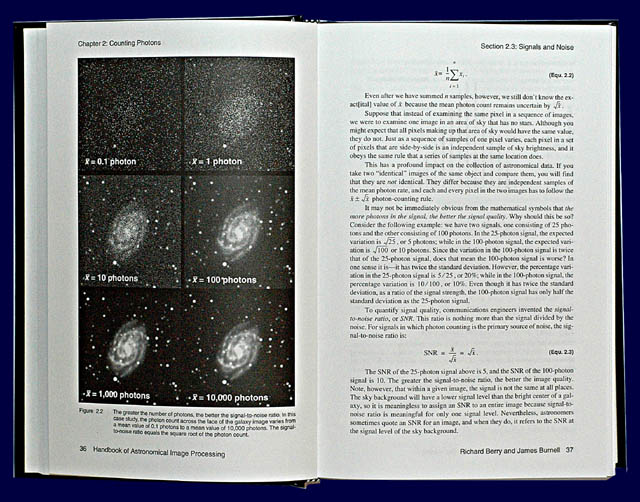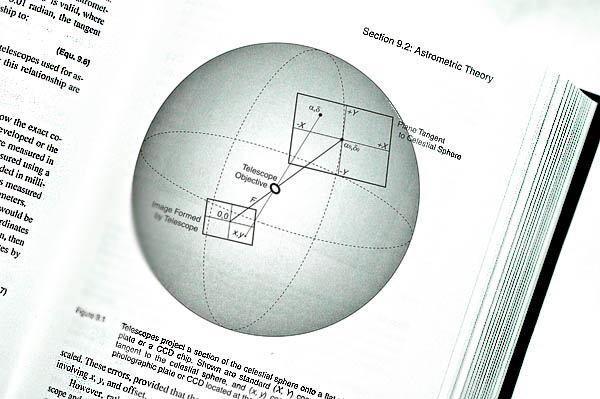 Astronomer-tested...
Astronomer-tested...The
Handbook of Astronomical Image Processing
with AIP4Win 2.0 software
Tools for Astronomical Image Processing
by Richard Berry and James Burnell
The "must-have" sourcebook and software for CCD imagers.
Every astronomer interested in CCD imaging and image processing needs a copy of the new revised and expanded Handbook of Astronomical Image Processing. Not only do you get the most complete reference on imaging and image processing, but you also get AIP4Win 2.0, a full-featured image-processing software included on a CDROM in the back of book. The total cost of this 684-page book plus the AIP4Win 2.0 software is only $99.95.
 Astronomer-tested...
Astronomer-tested...
When we set out to create AIP4Win, we analyzed the way that amateur astronomers work with images, and we created a software package designed to facilitate that workflow. Then realizing that not everyone has the same work style, we recruited serious CCD observers as beta testers, each of them working on their favorite imaging project, to give each software "tool" a thorough workout.
Our team of beta testers tested and re-tested every feature, and re-tested every new version as we added new features and functions to the program. After it was released, we paid strict attention to every user report and every request for new features. Then we tested every algorithm and every procedure, and carried out astrometry, photometry, and spectroscopy projects to test results. We shaped countless histograms, blinked images for supernovae, and made CCD movies.
The result is AIP4Win 2.0, a powerful program that is not only intuitive and easy to use, but also a program that is thoroughly tested and proven by thousands of users. AIP4Win 2.0 is a powerful solution to just about any astronomical imaging project.
 Software that works for you...
Software that works for you...
Here are just a few of the projects that you can accomplish with AIP4Win 2.0:
Creating images of astonishing beauty...
Tracking details of Jupiter's atmosphere...
Hunting asteroids, comets, and supernovae...
Picturing favorite deep-sky objects...
Generating light curves of variable stars...
Recording spectra of planetary nebulae...
AIP4Win 2.0 runs on any computer running Windows 95, 98, NT, 2000, and XP. For your satisfaction, the authors recommend the following minimum specifications:
Operating System: Win95/98/NT/2000/XP
CPU: Pentium or Athlon 1 GHz or higher
RAM: 256 megabytes minimum; 512 megabytes or more preferred
Graphics: 1024 x 768 or better, 16-bit or 24-bit display
Hard Disk: 20 megabytes free space available
CD-ROM reader: 16x or better
The Handbook complements and extends what you learn, and is NOT a software manual. The software manual is a massive on-line help file always ready to give you answers at a moments notice, a context-sensitive on-line guide to the software. The Handbook and AIP4Win 2.0 are sold together as a complete package. Under no conditions do we allow the software to be split from the book or the book to be separated from the software.
The reference book you'll keep beside your computer!

Delve into the ideas behind imaging and image processing...
The Handbook of Astronomical Image Processing is a valuable and authoritative reference work on image processing. The Handbook covers all aspects of image processing at the fundamental level of a reference work you will consult for years to come. Detailed chapter cover fundamental topics:
Basic imaging: How the light that falls on your CCD becomes an image. Covers image formation, cameras, telescopes, detectors, sensor geometry, image capture, field of view, and angluar coverage.
Counting Photons: "Astronomy is about counting photons...." Covers signal, noise, the signal-to-noise ratio, the Poisson and Gaussian distributions and why they matter, making better pictures by summing images, and how dark frames and flat frames effect the signal and noise in your images.
Digital Image Formats: Covers the file formats that astronomers use, including FITS, TIFF, BMP, and JPEG. Learn file format basics, how your image data is arranged inside the file on your computer's hard disk.
Imaging Tools: All about sensors, optics, cameras, and telescopes. Explains how to calculate the field of view and resolution of your system, telescope optics for imagers, auxiliary optics, mounts, drives, tracking, filters, and how to recognize and correct common equipment problems.
Imaging Techniques: "Good equipment is only half the story!" Covers the techniques that experienced imagers use to obtain high-quality images. Includes polar alignment, good guiding, critical focus, correct exposure, darks and flats, light boxes, and special considerations for DSLR cameras
Image Calibration: Examines the nitty-gritty details of image calibration. All about bias, dark noise, flat-fielding, standard and scalable darks, cosmic rays, making master dark frames, flats, standard calibration protocols, and defect mapping and correction.
Image Analysis: "Locked within the numerical values that make up a calibrated CCD image is a staggering amount of information." Covers pixel coordinates, pixel value, image statistics, the image histogram, feature analysis, the centroid, distances, and image profiles.
Measuring CCD Performance: How to measure the performance of your CCD camera. Discusses goals in measuring CCD performance, how to shoot test images, and the determination of bias level, dark current, gain, linearity, and readout noise.
Astrometry: Asteroid hunters measure the postions of new-found objects using astrometry. Covers the theory behind finding right ascension and declination from a CCD image, practical astrometry, and the uses of astrometry.
Photometry: Amateur observers now work side by side with professional astronomers to measure the variations of variable stars, supernovae, asteroids, and comets using the CCD to capture precise measures of brightness.
Spectroscopy: An emerging area for amateus astronomers brought to you by the CCD camera. Covers spectra and spectrographs, gratings, prisms, slit- and slitless systems, and the properties and meaning of stellar spectra.
Geometric Transforms: Covers translation, rotation, scaling, flipping, cropping, floating, and resampling. Demystifies the basic geometric operations used in astronomical image processing.
Point Operations: Learn how software converts the pixel values your CCD camera captures into the sparkling images you see in popular magazines and amateur websites. Remapping, transfer functions, linear, log, and exponential scalings explained. Covers endpoint specification and histogram specification.
Linear Operators: All about one of the most useful tools in the amateur astronomer's digital toolbox. Describes how digital convolution performs crispening, sharpening, smoothing. Learn about low-pass and high-pass kernels, Sobel, Kirsch, and Prewitt operators, and that most useful of linear tools: the unsharp mask.
Non-Linear Operators: Non-linear operators perform useful services like cleaning up noisy images. Cover rank-order processes, the median filter, local adaptive sharpening, noise filters, and morphological operators.
Image Operations: Multi-image operations are the basic tool for making superior astro-images. Covers image math, median-combine stacking, image registration, blinking, and track-and-stack image summing.
Images in Frequency Space: Unlocks the mysteries of the Fourier Transform and image processing in the spatial frequency domain. These powerful techniques used by profession astronomers are now accessible to amateurs.
Wavelets: Explores the hottest new image processing and restoration techniques. Covers the wavelet transform, the inverse wavelet transform, spatial filtering, the wavelet noise filter, and iterative filtering techniques.
Deconvolution: Deconvolution attempts to restore images degraded by a turbulent atmosphere, poor telescope optics, and tracking errors. Discusses algorithms used to sharpen Hubble Space Telescope images, how they work, and how amateurs can use them.
Building Color Images: You've seen fantastic astro-images on the web and in popular magazines and books. Learn how astronomers capture and build color images from multiple exposures through different color filters. Covers the colors of astronomical objects, luminace, chrominance, color space, white balance, G2V stars, RGB and LRGB color image capture.
Processing Color Images: The digital SLR camera has done much to bring color imaging to the average amateur astronomer. Explains the Bayer array, color image bit depth, noise, dark current, vignetting, calibration, image stacking, and luminace enhancement techniques.

Profusely illustrated.
Dozens of image case studies.
Clear, non-technical language to explain technical ideas.
Overall: an incredible value!
Tutorials make image processing fun to learn...
In the book and on the CDROM included with the book, the authors have provided 13 tutorials designed to introduce you to AIP4Win 2.0. The tutorials provide concrete demonstrations of the subjects covered in The Handbook of Astronomical Image Processing. The tutorials are as follows:
Image Enhancement: Discover how to extract detail from otherwise bland images. More than producing "pretty pictures," using the techniques will demonstrate to your enhanced details and show structures that, due to their low contrast, might otherwise be invisible.
Processing Multiple Images: Here is power at your fingertips! Calibrate an entire imaging session's worth of images at one time automatically. Align and enhance a set of images in preparation for creating a movie. Align and combine a group of images to create a single, "deeper" image. Process hundreds of planetary images.
Image Registration and Blinking: Registration and blinking are key tools in searching for asteroids and patrolling for supernovae.
Building Color Images: Learn how the "Join Color Tool" helps you to create stunning color images hassle-free from sets of red/green/blue filtered images.
Wavelet Noise Filtering: Experiment with one of the newest and hottest image-processing technologies. Wavelets are used by professional astronomers to analyze images from spacecraft.
Deep Sky Images: Learn the best ways to process a wide variety of deep-sky images, including the calibration and enhancement of a typical track-and-stacked deep-sky image.
Planetary Images: In this tutorial, you process an outstanding image of Jupiter using brightness scaling, unsharp masking, and deconvolution tools.
Thousands and thousands of satisfied users...
Because AIP4Win 2.0 outperforms competitive software packages costing much more, it has attracted many thousands of users. Coupled with The Handbook of Astronomical Image Processing, it is best way to learn about image processing, and the best way to process your CCD images.
The
Handbook of Astronomical Image Processing, 2nd edition
plus
AIP4Win
2.0

The "must-have" sourcebook and software for CCD imagers.
684 pages; software CDROM included in the book
$99.95
Order
direct from the publisher
Willmann-Bell,
Inc.
Back to Astronomy Books by Richard Berry